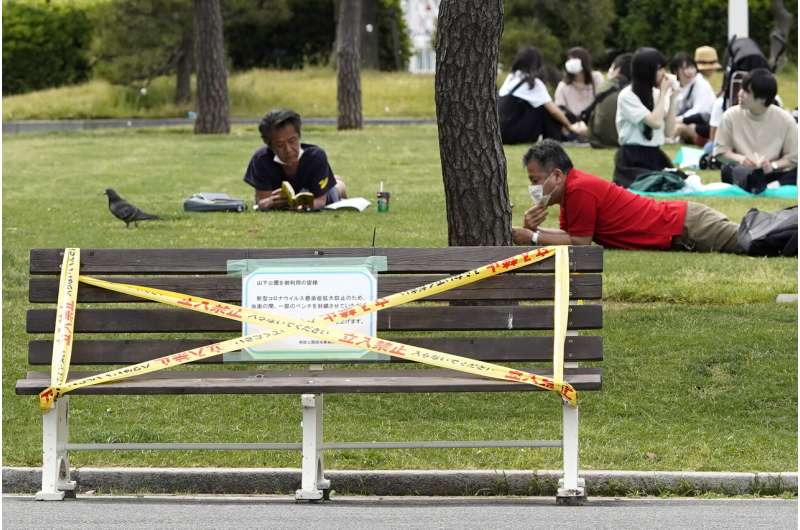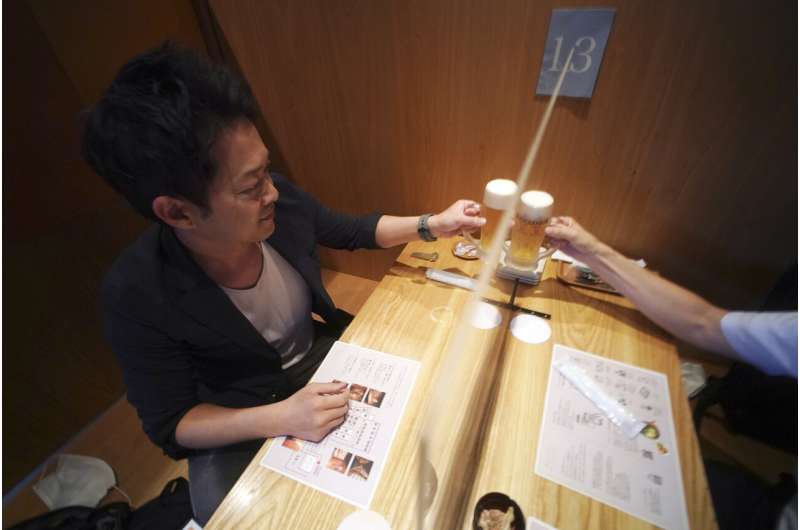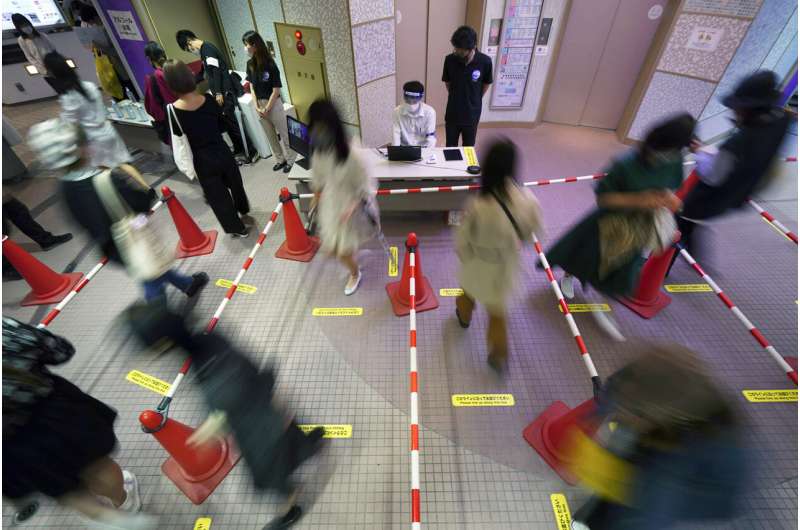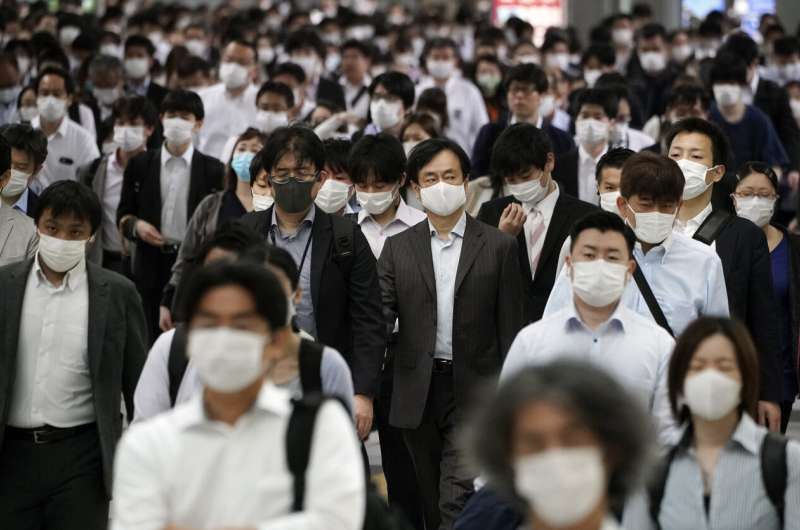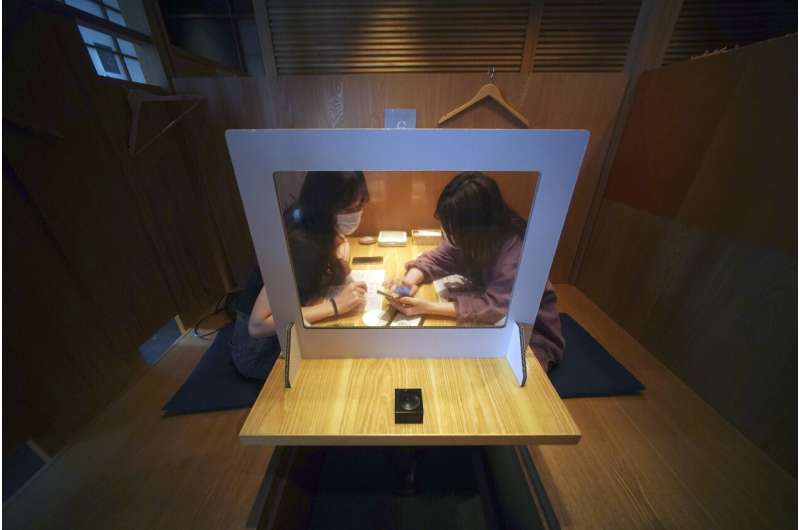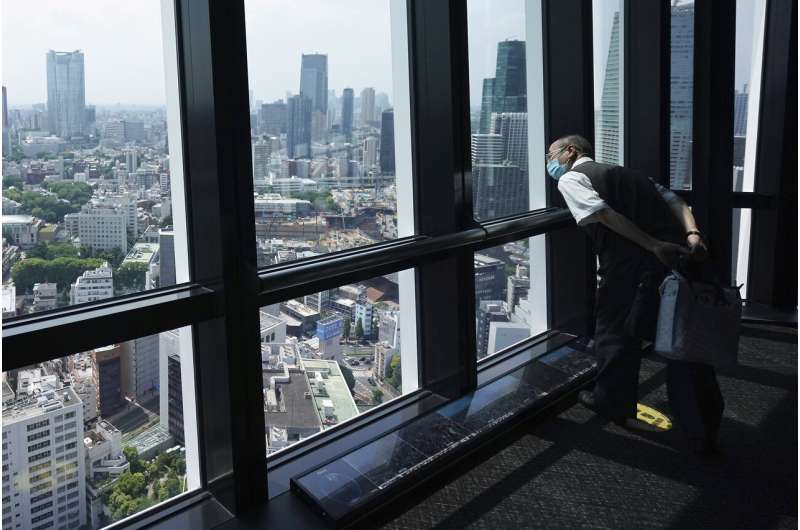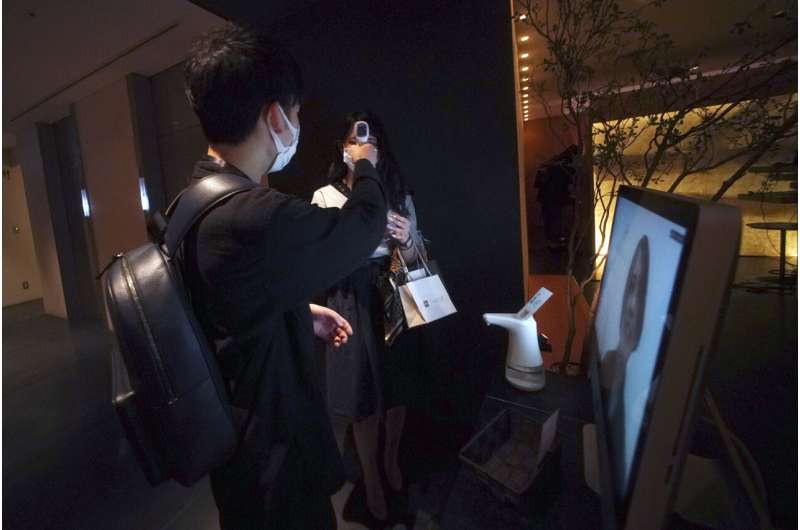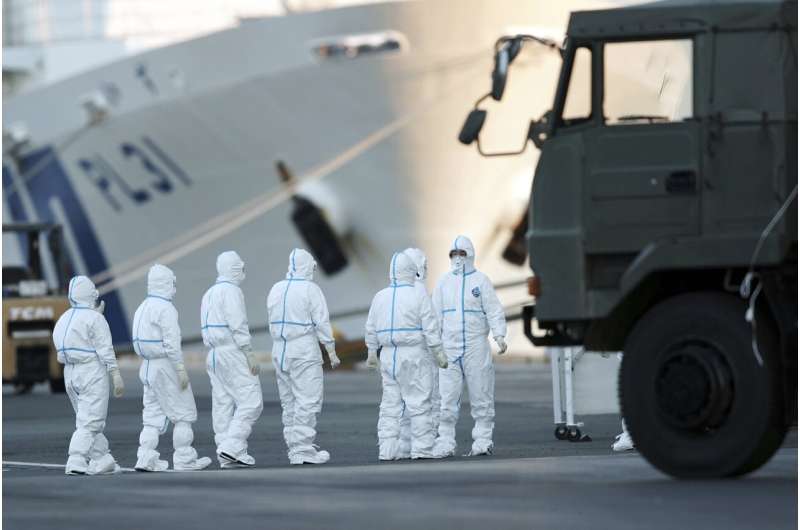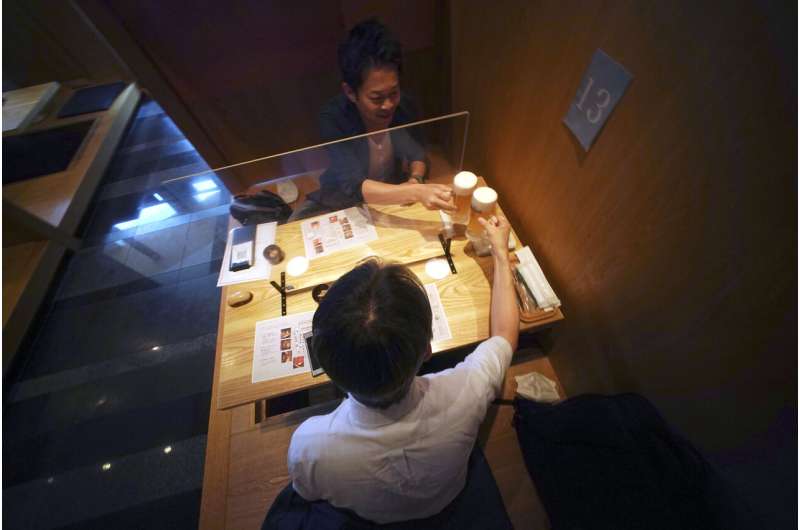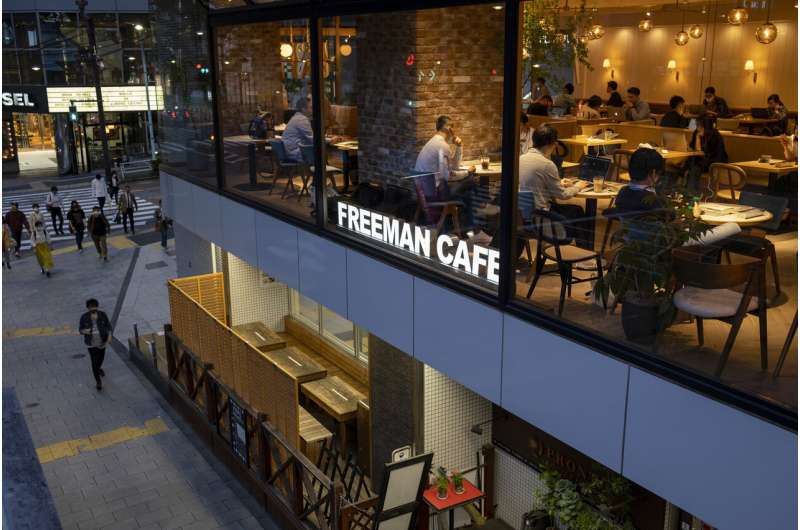In this May 14, 2020, file photo, people rest on the grasses at a park in Yokohama, Kanagawa prefecture, near Tokyo. As Japanese return to schools, shops and offices reconfigured to help prevent new coronavirus infections with ample use of plastic screens, masks and reminders to keep their distance, access to faster testing is crucial, officials say.(AP Photo/Shuji Kajiyama, File)
Japan has kept its deaths from the new coronavirus low despite a series of missteps that beg the question of whether it can prevent future waves of infections.
Authorities were criticized for bungling a cruise ship quarantine and were slow to close Japan's borders. They have conducted only a fraction of the tests needed to find and isolate patients and let businesses operate almost as usual, even under a pandemic state of emergency.
But the roughly 900 deaths, or 7 per million people, in Japan are far fewer than the 320 per million in the U.S. and more than 550 per million in Italy and Britain.
Prime Minister Shinzo Abe on May 25 declared an end to a 7-week pandemic state of emergency, lauding "the power of the Japan model" and winning World Health Organization chief Tedros Adhanom Ghebreyesus's praise as a "success."
Experts say it's unclear exactly how Japan has managed to keep outbreaks in check, but the country needs to use the reprieve to beef up testing and healthcare systems to better find, isolate and treat patients to minimize future waves of infections.
A government-commissioned panel concluded that early contact-tracing helped pinpoint outbreaks, slowing the spread of the virus until late March, when a surge of cases overwhelmed the extremely labor intensive process of investigating clusters of infections.
Customers drink a toast through plastic partitions at Kichiri, an "izakaya" restaurant at Shinjuku district in Tokyo Thursday June 4, 2020. At the restaurant, customers pass through a gate to get whole-body disinfectant smoke, follow a mobile map to their tables and order from tablets with sensors allowing touchless operation. Seats are divided with plastic partitions and dishes delivered with plastic covers. (AP Photo/Eugene Hoshiko)
A campaign to get the public to avoid high-risk environments, dubbed the "three Cs," or close contact, closed settings and crowded places, also helped, it said.
"At a relatively early stage, we detected signs of infections and we were aware of how the coronavirus transmits ... We were able to warn the people against the '3 Cs' from early on," said Shireru Omi, a public health expert and leading figure on the government task force.
"Japan could have been like (the U.S. or Europe) if infections had overshot at the beginning," he said.
Omi and other experts say widespread use of masks to fend off allergies and prevent sharing colds; the Japanese custom of bowing instead of shaking hands or hugging; a taboo on wearing shoes inside homes and a highly accessible, affordable public health system all helped.
In this June 1, 2020, file photo, shoppers maintain social distancing as they walk in line to enter reopened Shibuya 109, a landmark and fashion building in Shibuya shopping distric, in Tokyo. As Japanese return to schools, shops and offices reconfigured to help prevent new coronavirus infections with ample use of plastic screens, masks and reminders to keep their distance, access to faster testing is crucial, officials say.(AP Photo/Eugene Hoshiko, File)
Patients who were hospitalized benefited from Japanese doctors' heavy reliance on CAT scans and X-rays to diagnose pneumonia cases. Researchers also suspect possible past exposure to other strains of coronavirus might provide some protection from the illness.
Or, Japan may just have been lucky so far, despite many missteps, some critics say.
Initially, hopes were high that Japan's system of public health centers, or "hokenjo," set up decades ago to track down tuberculosis and other infectious diseases, might be a powerful weapon against the pandemic.
Instead, gutted by steep staff cuts and restructuring, they became bottlenecks as they were flooded with tens of thousands of phone calls and testing requests. Bureaucracy prevented commercial and university labs from helping, as some people sickened and died before their calls were even answered.
A station passageway is crowded with commuters wearing face mask during a rush hour Tuesday, May 26, 2020, in Tokyo. Japan has kept its deaths from the new coronavirus low despite a series of missteps that beg the question of whether it can prevent future waves of infections. (AP Photo/Eugene Hoshiko, File)
"A public health perspective was prioritized, and treatment for each patient was neglected," Michiko Sakane, a doctor in Tsukuba, near Tokyo, said in a recent article published by the Medical Research Information Center. "We had to keep asking patients with flu symptoms to wait at home. We don't even know how many of them were positive," she said. "We needed a system that allow us to test anyone who needed to be tested."
Infections spread in hospitals, as meanwhile emergency rooms often rejected suspected COVID-19 patients due to shortages of protective gear, ventilators and intensive care beds.
The handling of the Diamond Princess cruise ship, on which 712 of the 3,711 people aboard gradually fell ill while being quarantined in the Yokohama port, triggered criticism that Japanese health officials had turned the vessel into a virus incubator.
Customers order drinks and food with their phone through plastic protector against the new coronavirus infection at Kichiri, an "izakaya" restaurant chain in Tokyo Thursday, June 4, 2020. As Japanese return to schools, shops and offices reconfigured to help prevent new coronavirus infections with ample use of plastic screens, masks and reminders to keep their distance, access to faster testing is crucial, officials say.(AP Photo/Eugene Hoshiko)
Hundreds of those patients flooded into hospitals just as the pandemic was gaining a foothold in the Tokyo-Yokohama region. Other passengers were eventually evacuated from the ship without reports of secondary infections.
Officials say tests were rationed to avoid overwhelming hospitals, since health ministry policy initially required hospitalization of all positive cases. Officials later agreed to isolate asymptomatic or mild cases in hotels.
Still, emergency medicine briefly collapsed, said Takeshi Shimazu, head of the Japanese Association for Acute Medicine. "If we had a bigger outbreak, we wouldn't have been able to cope."
By early June, Japan had tested some 254,000, or only 0.2% of its 126 million people, a fraction of the numbers tested in the U.S., Germany and South Korea.
Omi has acknowledged the actual number of infections could be 10 or 20 times, or more, the health ministry's tally of nearly 17,000.
In this May 28, 2020, file photo, a visitor looks outside from Tokyo Tower, one of the town's travel spots, as it reopened the observatories in Tokyo. Japan has kept its deaths from the new coronavirus low despite a series of missteps that beg the question of whether it can prevent future waves of infections. (AP Photo/Eugene Hoshiko, File)
So far, government appeals to businesses to let employees work remotely; limited shutdowns of some businesses and schools and voluntary compliance with calls to avoid crowds appear to have turned the tide.
Numbers of new cases have dropped dramatically, though they have rebounded in recent days, a reminder of how easily the new coronavirus can spread.
One priority is to better protect the nearly one-third of Japanese over 65 in this fastest aging nation, said Tatsuhiko Kodama, a Tokyo University Immunologist.
As Japanese return to schools, shops and offices reconfigured to help prevent infections with ample use of plastic screens, masks and reminders to keep their distance, access to faster testing is crucial, officials say.
The government has revised its testing guidelines and is setting up dozens of testing stations, introducing quick test kits for early detection. Some antibody testing has begun to assess the extent of infections and a contact-tracing app for both Apple and Google smartphones is under development.
-
A restaurant employee, on monitor, remotely attends as customers check their temperatures before entering the restaurant as a measure against the new coronavirus prevention at Kichiri, an "izakaya" or Japanese style restaurant at Shinjuku district in Tokyo Thursday, June 4, 2020. As Japanese return to schools, shops and offices reconfigured to help prevent new coronavirus infections with ample use of plastic screens, masks and reminders to keep their distance, access to faster testing is crucial, officials say. (AP Photo/Eugene Hoshiko)
-
In this Feb. 10, 2020, file photo, officials with protective suites prepare work around the quarantined cruise ship Diamond Princess in the Yokohama Port, near Tokyo Japan. The handling of the Diamond Princess cruise ship, on which 712 of the 3,711 people gradually fell ill while being quarantined in the Yokohama port, triggered criticism that Japanese health officials turned the ship into a virus incubator. (AP Photo/Eugene Hoshiko, File)
-
Customers drink a toast through plastic protector against new coronavirus infection at Kichiri, an "izakaya" restaurant chain in Tokyo Thursday, June 4, 2020. As Japanese return to schools, shops and offices reconfigured to help prevent new coronavirus infections with ample use of plastic screens, masks and reminders to keep their distance, access to faster testing is crucial, officials say. (AP Photo/Eugene Hoshiko)
-
A crowded coffee shop is seen in Tokyo Friday, May 15, 2020. Japan has kept its deaths from the new coronavirus low despite a series of missteps that beg the question of whether it can prevent future waves of infections. (AP Photo/Kiichiro Sato)
Authorities are on the lookout for further outbreaks of the virus that has cost the country hundreds of lives and trillions of yen (trillions of dollars) in lost production, consumer spending and tourism revenues—and in government spending to help salvage the economy.
When Tokyo confirmed 34 new COVID-19 cases on Tuesday, its governor declared an "alert," lighting the city government headquarters and the scenic Rainbow Bridge over Tokyo Bay in crimson.
Shimazu fears such largely symbolic measures won't prevent a resurgence of infections as people once again crowd onto trains and gather in cramped offices and classrooms.
"How effective can masks, social distancing and hand washing be?" he said. "I'm watching the situation with great concern."
© 2020 The Associated Press. All rights reserved. This material may not be published, broadcast, rewritten or redistributed without permission.
